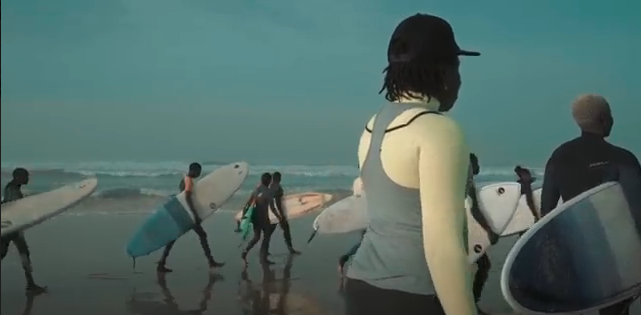Why the Impact of Climate Change on Sport Is an Environmental Justice Problem
Why this matters
Issues of access and health in sport are being exacerbated by climate change, making clean air at outdoor fields, safe playing surfaces, and comfortable temperatures a matter of environmental justice in sport.
When most of us think about how climate change is altering – and even threatening – the sports world, we picture major and mega events: the first Winter Olympics held using artificial snow, the first World Cup held in November and December (to avoid the searing summer heat in host country Qatar), Major League Baseball and National Football League games affected by the smoke from raging wildfires, and college football games moved, postponed, and canceled because of hurricanes.
However, rising global temperatures also are affecting sport in a less visible but no less important way: by reducing opportunities at all levels, including youth and community-based activities, for people to participate in and reap the benefits of sports. This is particularly true for members of traditionally marginalized groups who already are considered more vulnerable to the effects of climate change – which means climate change’s effect on sport is a matter of environmental justice.
What Does Environmental Justice Mean?
The term environmental justice refers to the social movement – and subsequent fields of scholarship and profession – dedicated to addressing societal inequities that exist due to harmful environmental conditions. Much like the social justice movements around systemic racism, gendered violence, and LGBTQ+ rights that have taken center stage in recent years, awareness around environmental injustice is growing due to increased attention on social and traditional media.
As with other forms of systemic discrimination, environmental injustice is driven by historical inequity along racial and socioeconomic lines. When it comes to the environment, such injustices come from a lack of access to green spaces, proximity to traffic and hazardous waste sites, and exposure to polluted air and water. Ultimately, America’s (and the world’s) infrastructure is organized in a manner that disproportionately places racial minorities and lower-income communities in risky locations where they experience the greatest and most detrimental effects of these geographical risk factors – and where they will feel the most severe impacts of climate change.
How Does Environmental Injustice Intersect With Sports?
Historically, Black and Brown communities in the U.S. have suffered sports-related environmental injustices. For example, these communities have had limited access to safe, affordable, well-lit, and well-maintained bike paths and swimming pools when compared to traditionally White communities – all of which puts these minority communities at greater risk of harm. From 2016 to 2018, Black and Latinx Americans took 18 percent of bike trips but suffered 31 percent of all cycling fatalities. Similarly, Indigenous and Black Americans suffer drowning deaths at rates twice as high as White Americans. These examples highlight inaccessibility related to sport, recreation, and environmental injustice.
Climate change figures to exacerbate these inequities.
Conditions such as extreme heat and weather, severe storms, and disappearing snow create additional opportunities for marginalized communities to be disadvantaged – widening the gap between society’s haves and have-nots, particularly when it comes to accessing sports in the first place. Consider skiing and snowboarding. Professional athletes in both sports, who have money and opportunities to participate, are losing access because of climate change. Elite competitors have to travel further and to higher altitudes to keep practicing and competing; the current alternative to this, artificial snow, is also expensive. As costs rise, resort-based winter sports that already are disproportionately wealthy and White could become even less diverse.
Golf faces a similar problem. Historically, the sport has been inaccessible to women, people of color, and low-income groups. As the climate changes, golf courses will be challenged by drought, rising sea levels, more severe storms, and hotter temperatures – and as solutions to those issues raise operating costs, the sport will also be challenged to remain accessible for all. The city of Minneapolis, Minnesota, has become a hub for the most recent systemic racism social justice movement following the murders of Philando Castile, George Floyd and Daunte Wright. As a result, dozens of grassroots efforts for justice have made their home in the Twin Cities. For golf, which largely remained segregated long after the Jim Crow era, Minnesotans are finally reckoning with the institutional racism in their area and how that has affected sport opportunity for Black people. Climate change is wreaking havoc on golf equity in Minneapolis as lower-income, predominantly-minority parks and courses are flooding and struggling to recover.
How Can Sport Be Used to Rectify Environmental Injustice?
As environmental injustice in sport becomes more frequent and harder to ignore, advocates are realizing that sport can be used to promote climate justice – either by rectifying inequities resulting specifically from climate change, or by supporting those who face disproportionate vulnerabilities because of it.
In New Delhi, India, for example, air pollution levels are more than twice that of Beijing on a typical day and have surpassed the Environmental Protection Agency’s “extremely hazardous” air pollution scale – enough, NPR reports, to leave high school basketball player Asheer Kandhari with watery eyes and struggling to breathe during practice. Her mother, Bhavreen Kandhari, has become a clean air campaigner who has spoken at the United Nations’ climate summit and is part of the “Warrior Moms,” a citizen group that successfully lobbied the city to close schools when pollution spikes.
In 2019, Christian Aid, a United Kingdom-based charity operating in nearly 30 countries, released a report pointing out that while Rugby World Cup participants and island nations of Fiji, Tonga, and Samoa contribute marginally to global carbon emissions, they will face some of the most extreme impacts from the rising sea levels and more severe storms brought about by global warming; in contrast, the wealthiest nations in the tournament, including Australia, Japan, and the U.K., are much more aggressive about burning fossil fuels. Retired Samoan player Jonny Fa'amatuainu, who also played professionally in England and Japan, asked Pacific Islanders participating in the World Cup to use their platform to encourage action on climate change.
With regard to drowning deaths among Black and Brown people, there are dedicated organizations such as Black Kids Swim, Black in Marine Science, and Diving with a Purpose that seek to create exposure and access to pools, swim lessons, and dive training for these communities – undoing centuries of water-based discrimination, fear, and systemic obstruction.
As the climate emergency becomes a priority for sports organizations and teams, new light is being shed on the inequities faced by disenfranchised groups. In Seattle, for instance, the National Hockey League’s expansion Kraken franchise is driving sustainable advancements in facility design and operations through Amazon’s Climate Pledge arena. After attention was brought to the incomplete nature of these efforts in the absence of climate justice, the team and arena organizations have been steadily working in encouraging ways to improve and diversify their justice efforts.
Creating Change
Opportunities to improve environmental and climate justice in sport are increasing, with organizations, prominent figures, nonprofits, and consumers alike demanding and creating change. EcoAthletes and Green Sports Blog are amplifying the voices of athletes, journalists, and scholars. Rapid Transit Alliance’s “Badvertising” report encourages sport sponsorships to move away from major carbon polluters the way they have abandoned tobacco companies. The Council for Responsible Sport includes diversity impact and social justice amplification and equity in the council’s guidebooks on hosting responsible sport events and being a responsible organization – advice that can be adopted at any level of competitive or recreational sport.
In Major League Soccer, the Seattle Sounders have prioritized carbon neutrality and acknowledged the connections between race and environmental injustice in their area – dedicating work around Earth Day to advancing justice work in low-income elementary school communities. The Vermont Green Football Club is using soccer as a vehicle to drive pro-environmentalism. Last year, Ireland’s Bohemian Football Club created waves by hiring the sport’s first Climate Justice Officer, Seán McCabe.
The stakeholders who are needed to address a large and global problem like climate change typically exist in independent silos: governments over here, industry over there, NGOs somewhere in the middle, each pursuing their own interests and agendas – and that’s the case even when they share the same goals. Likewise, sports are hardly monolithic. International organizations like the Olympics, national leagues, local teams, and myriad grassroots entities all have decision-making power. To drive positive change and address environmental injustice by promoting equity within and accessibility to sport, deeper, wider, and more diverse collaboration will be needed.
The need is urgent. Inaction and a lack of progress in addressing climate change and social injustice have the potential to harm sports – and deny countless people the fun, entertainment, and physical and emotional health benefits that sports can provide. Moreover, when fewer people play sports, fewer people watch sports, because fewer people care about them. For the sports world, maintaining the status quo is simply not a sustainable option. Although many organizations have implemented timely and necessary environmental sustainability initiatives like reforestation, waste diversion, and energy efficiency, these outward-facing efforts must also tackle environmental inequities, specifically those stemming from the climate crisis. As Earth Day draws near, the hard work of achieving environmental justice within sports is only just beginning.
Monthly Issue
The Sustainability of Sport
Sport is a large-scale global pursuit that brings together people and places, often creating deep roots with the environment in which it is played. As a result, sport both contributes to ecological change and is affected by it.
As efforts intensify to address decades of carbon emission, commercial growth, and environmental deterioration, sport can take the lead in championing progress. If current trends continue, however, sport could face some of the more serious consequences of a changing Earth.



